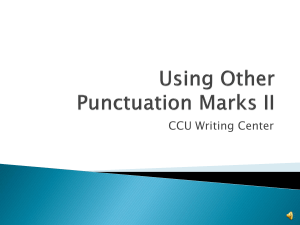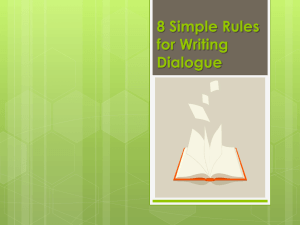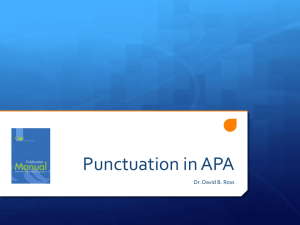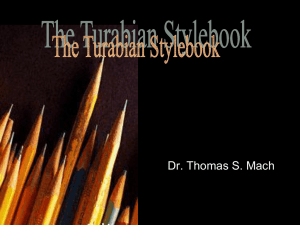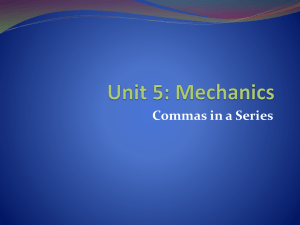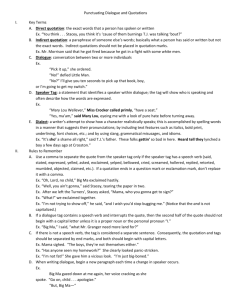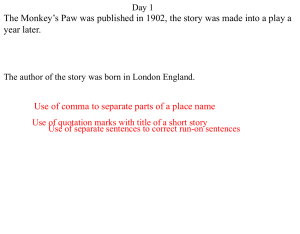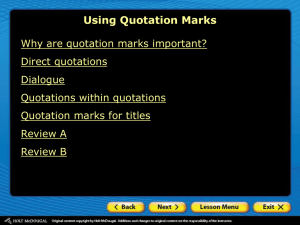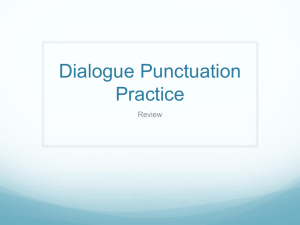OST164 Chapter 6 - Other Punctuation
advertisement
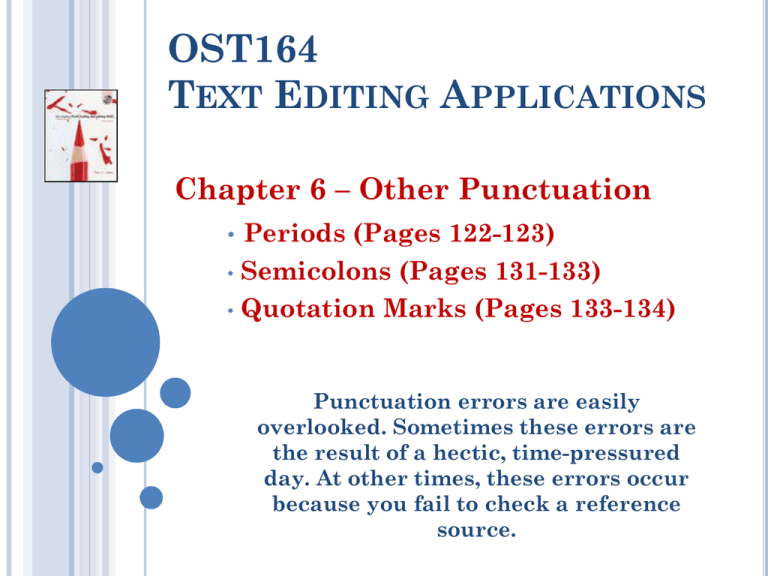
OST164 TEXT EDITING APPLICATIONS Chapter 6 – Other Punctuation Periods (Pages 122-123) • Semicolons (Pages 131-133) • Quotation Marks (Pages 133-134) • Punctuation errors are easily overlooked. Sometimes these errors are the result of a hectic, time-pressured day. At other times, these errors occur because you fail to check a reference source. RULES FOR PERIODS Use a period to end a sentence or command. Cultural diversity is an important issue in business. Do not answer any questions they ask you without a lawyer. Use a period to end a polite request-a question where the person spoken to is likely to respond by doing what is requested instead of simply answering the question. Polite Request: Will you please fax me your response by Friday. Would everyone in the room who hasn't received an ID card please move to the front of the line. How could I have known that those documents I had sent were top secret. Question: Do you think you can fax me your response by Friday? Should I have know that those documents I had sent were top secret? RULES FOR PERIODS Use a period after numbers or letters that enumerate items in outlines or displayed lists. Also, add a period at the end. We need to : 1. Revise our hiring procedures. 2. Develop a training program. 3. Implement an incentive plan. Last week, we: A. Revised our operations manual. B. Decided on a new pay scale. Note the usage of the COLON in each sentence as well. C. Decided who to promote next month. The items in a list do not end with periods because they appear to be a list of inventory items. We need to take: We need to take: • A sleeping bag 1. A sleeping bag • A tent 2. A tent • A box of matches 3. A box of matches RULES FOR SEMICOLONS Semicolons are used to join items. The most common use of the semicolon is to join two closely related independent clauses that are not joined by a coordinating conjunction (and, but, or, not). Daryl took the photographs today; the prints should be ready by tomorrow. Doug supported the legislation; his colleagues voted against it. RULES FOR SEMICOLONS The semicolon is used to join two related independent clauses when the second clause begins with a transitional expression such as therefore, however, for example, consequently, or moreover. Chelsea was late again this morning, however, she had a legitimate reason this time. Jason contributes regularly to his retirement account; consequently, his monthly retirement check will be sufficient. Ms. Clarke refused to increase our advertising budget; she suggested, moreover, that we decrease it by at least $500. RULES FOR SEMICOLONS The semicolon replaces the comma in a series when one or more of the items in the series already includes a comma. WRONG: Greta will be consulting in Chicago, Illinois, Columbia, South Carolina, St. Louis, Missouri, and Bristol, Tennessee. RIGHT: Greta will be consulting in Chicago, Illinois; Columbia, South Carolina; St. Louis, Missouri; and Bristol, Tennessee. Those who will attend the meeting are Jane Smith, an Avon representative; Tina Ray, a Mary Kay representative ; and Anne Jones, an Arbonne representative. CHECKUP 6-4 #3 Tara adjusted the temperature in the room; Ruth still complained of being cold. #4 Our holiday policy is very generous; for example, we are allowed three personal days to use at our discretion. #8 My plane was late; however, I did not miss my connecting flight. #10 Your deposit wasn’t made until 4:45 p.m. today; therefore, it will not be credited to your account until tomorrow. #13 Jaya will demonstrate our products in Tampa, Florida; Raleigh, North Carolina; Denver, Colorado; and Austin, Texas. RULES FOR QUOTATION MARKS Use quotation marks to enclose a person’s exact words. “Our sales figures are good,” Brittany said. “In fact, we are exceeding our expectations.” “You will be amazed at the wealth of data available at our Web site,” said Bryant Mayo, our business information manager. Note that the comma and the period belong inside the closing quote. RULES FOR QUOTATION MARKS Use quotation marks to enclose the titles of parts of books, magazines, newspapers, or other published works. These include titles of chapters, articles, and essays. The fifth chapter, “Supervising Difficult People,” is the most useful one in the book Management Challenges. Her article “Capitalizing on E-Commerce” appeared in the Los Angeles Times. I didn’t read her article “How to Use a Computer”; therefore, I can’t discuss it with you. Note that the colon and the semicolon belong outside the closing quote. RULES FOR QUOTATION MARKS Quotation marks are used with special words or phrases that follow the words marked, stamped, titled, and labeled. Please mark this package “Fragile.” The CD-ROM is labeled “For individual use only.” Have the manufacturing personnel stamp on the material “Do not remove.” QUESTION MARK AND QUOTATION MARK Put question marks either inside or outside closing quotation marks, depending on whether the marks apply to the quoted words only or to the entire sentence. Question Mark Have you read William Simpson’s latest article, “That’s the Way Technology Works”? Outside because the entire sentence is a question. I heard Lisa say, “What do you think you are doing?” Inside because only the quoted sentence is a question. What do you think of the chapter “Wireless Accessibility”? Outside because the entire sentence is a question. Please be sure you read the article “Is a Wireless Homes in Your Future?” Inside because only the quoted sentence is a question. RULES FOR THE UNDERSCORE AND ITALIC Underscores have traditionally been used to provide emphasis in typed material. However, italic type if more commonly used instead to emphasis words. Words that represent the actual words are usually underscored but may also appear in italics. Words should appear in italic. Through this report, the words affect and effect are used incorrectly. All employees should understand the term sexual harassment. RULES FOR THE UNDERSCORE AND ITALIC Titles of books, magazines, newspapers, plays, and other COMPLETE WORKS may be underscored. These titles are more often typed in italics or in allcapital letters. Three of Alice Hyatt’s best-selling books are Healthy Living, Fit for Life, and Food for Fitness. Partial works = quotation marks Complete works = italicized The article “How to Breathe” was located in the magazine Asthma in Today’s Society. NOTE: Do italicize any punctuation that appears before or after the title. REVISION SYMBOLS To insert a question mark, simply write in the question mark. Is the project completed? Insert a quotation mark “ “ He said, Yes, I will. Transpose punctuation Ben asked, “Who ordered the pizza”? Italicize Her book it titled “Enhanced Design.” ital #1 Was the fax marked “Notify Recipient on Arrival”? (question mark goes outside the quotation mark) #2 The attorney asked, “Do you agree with the proposed settlement?” (question mark goes inside the quotation mark) #3 The menu erroneously listed desert instead of dessert. #4 Can you meet with us on September 10? #5 The accountant asked, “Was the invoice mailed yesterday?” (question mark goes inside the quotation mark) #6 The word mistake has a negative connotation. CHECKUP 6-5 CHECKUP 6-5 (CONT’D) #7 Coretta excitedly announced, “I’m going on a cruise!” (quotation mark goes inside the quotation mark) #8 The article “Exercise for Executives” appeared in Business Today, which is a local magazine. #9 “We anticipated that additional research will confirm our claims,” stated the manager. #10 “We agree with your decision, “ Miguel said, “but we prefer taking immediate action instead of waiting until Monday.”


